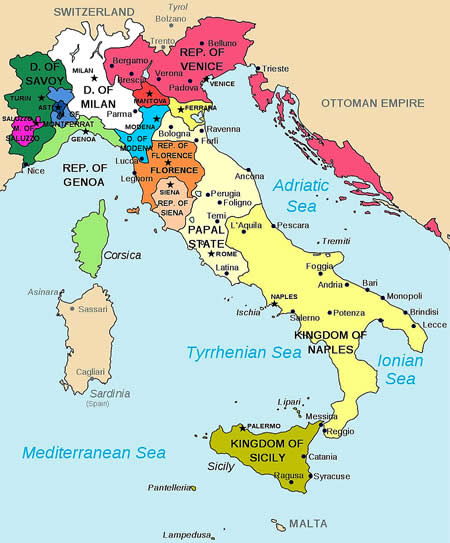 |
| Italian City-states |
The history of Italy is the history of cities. This was especially true in the late Middle Ages and early Renaissance when Italian cities gained such economic and political prominence that, independently of one another, many were considered actors on the European political stage.
Generally defined, city-states were cities that had won their independence from the Holy Roman Empire or the papacy. Instead of recognizing the pope or emperor as the highest authority, they held popular sovereignty as a guiding principle.
They tended to prioritize controlling the region surrounding the city, called the contado, such that some eventually became large territorial states. The Italian city-states of the 14th and 15th centuries are recognized today for the profound infl uences that they had on the development of the Western political, economic, artistic, and literary tradition.
  |
Throughout the Middle Ages the Italian peninsula (especially its northern half) was one of the most urbanized areas of Europe, with up to 30 percent of people living in cities. Some such as Rome, Naples, Florence, Milan, and Venice were larger, while others such as Perugia, Siena, Pisa, Ferrara, Urbino, or Verona were small.
In the Middle Ages almost all these cities owed allegiance and taxes either to the Holy Roman Emperor or to the papacy. Imperial cities generally adhered to the Ghibelline party, and papal cities, to the Guelf. The emperors’ and popes’ repeated demands for military and financial support for endless wars exhausted city dwellers and spurred movements for independence.
The first great victory for the cities came in 1183, when the German emperor Frederick I at the Treaty of Constance recognized the independence of the northern Italian cities. The papacy’s 14th-century departure for Avignon in southern France allowed many disgruntled cities to proclaim independence.
The city-state was a phenomenon of northern Italy. It did not appear in the south, as both Naples and Sicily remained firmly under the power of the royal houses of Aragon and Anjou. In the north, the major city-states to emerge were Florence, Venice, and Milan. Rome achieved a similar status in the 14th century while the papacy was in Avignon but in the 15th century was brought again under papal control.
 |
| Renaissance city of Florence |
After throwing off the traditional lordship of pope or emperor, many cities turned to ideas of popular sovereignty at the expense of traditional elite prerogatives. They developed complex political processes to bar elite families from governing.
New advances in commerce and banking, such as the concepts of credit, insurance, and bookkeeping, aided the development of an urbanized merchant class. These new sources of wealth reduced the dependency on land and, as a consequence, the power of the traditional landed nobility.
These changes were bolstered by developments in legal theory. The 1293 Ordinances of Justice, for example, prohibited elite participation in Florentine politics. In Rome, the popular leader Cola di Rienzo (c. 1313–54) led a movement aimed at curtailing the privileges of the city’s noble families.
   |
Although 19th-century historians liked to see in the Italian city-states nascent forms of democratic rule, popular regimes were hardly ever open to the lower echelons of society, or the popolo minuto. Most were in fact headed by what was often termed the popolo grasso—the educated lawyers, successful merchants, and nonnoble landowners with the financial and social wherewithal to bring them to the forefront of the political stage. Only isolated occasions such as the 1378 Ciompi revolt in Florence brought the popular minuto to power, and their political lifespans were inevitably short.
Despite efforts at curtailing noble power, elite families were never entirely sidelined from most civic governments. In Venice, for example, participation in government was reserved for the hereditary elite. Some families, such as the Visconti, and later the Sforza in Milan, the Carrara in Padua, and the della Scala in Verona, became the de facto lords of the city. Even Florence, arguably the most republican, had by the 1430s in all but rhetoric accepted the Medici as the city’s primary power.
In response to the complex diplomatic conditions of the time, political thought in the Italian city-states flourished. Thinkers such as the notary Bruno Latini (c. 1220–94), Marsilius of Padua (c. 1275–1343), and the jurist Bartolus of Sassoferrato (1314–57) all elaborated political theories that justified and paid tribute to republican government.
Others such as the Florentines Coluccio Salutati (1331–1406) and Leonardo Bruni (1370–1444) wrote highly rhetorical pieces aimed at illuminating the ideological struggle between what they saw as virtuous republican government and the champions of tyranny in the signoria of other cities such as Milan.
And Niccolò Machiavelli, whose political acumen derived from observing the civic strife of Florence and her neighbors at the turn of the 16th century, left an indelible imprint on Western political thought with his theories of republican and princely government.
Art and architecture flourished as well in the Italian city-states. Economic prosperity allowed for great public building projects such as cathedrals, libraries, and government palazzi, all of which proclaimed the city’s greatness.
Artists like Ambrogio Lorenzetti illustrated the benefits and ills of good and bad government in his 1338–39 frescoes in Siena’s Palazzo Pubblico. Venice from the late 15th century on was at the forefront of printing press technologies, while Rome in the same period served as a center for a mature humanistic culture.